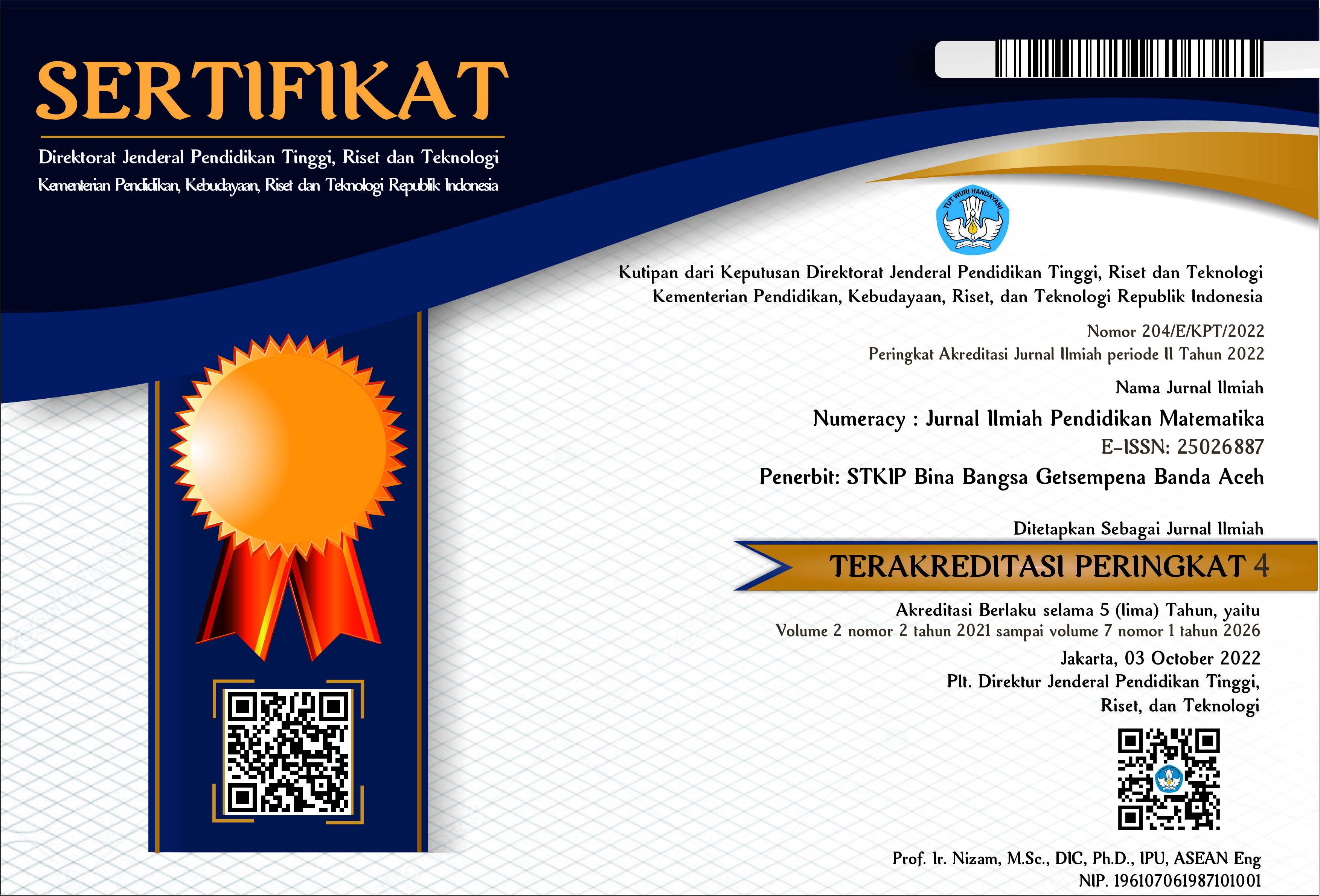PENGEMBANGAN DAN HAMBATAN SISWA DALAM MENINGKATKAN KEMAMPUAN BERPIKIR TINGKAT TINGGI MATEMATIKA MELALUI METODE IMPROVE
Abstract
This study overall develops models/learning tools for higher order thinking mathematics using the IMPROVE method which is valid, practical and effective using the ADDIE (Analysis, Design, Development, Implementation and Evaluation) model. However, specifically in this paper, the researcher reveals the other side of the development results of these learning tools, namely the development and obstacles faced by students in increasing higher-order thinking skills (Higher-Order-Thinking). Therefore, the specific objective of this study is to determine the development trend of students' higher order thinking skills and the difficulties encountered during learning. The research instruments were student on-task activity sheets, student activity observation sheets, formative tests and learning outcomes tests. The test was conducted on 66 students of class X SMAN 3 and SMAN 5 Banda Aceh as samples. The test results show that the mathematics learning device is valid, practical and effective in accordance with predetermined product criteria. The tendency for the development of high-order thinking skills (HOTS) of students in formative exercises (T1 and T2) moved up and the Learning Outcomes Test was good, on average 72%. The difficulties faced by students are dominant in indicators of creation and evaluation. The implication of this study is that higher order thinking mathematics learning model with the IMPROVE method and metacognitive strategies can be used for class X SMA students.
Abstrak
Secara keseluruhan studi ini melakukan pengembangan model/perangkat pembelajaran matematika berpikir tingkat tinggi dengan metode IMPROVE yang valid, praktis dan efektif menggunakan model ADDIE (Analysis, Design, Development, Implementation and Evaluation). Namun secara khusus dalam tulisan ini, peneliti mengungkapkan sisi lain dari hasil pengembangan perangkat pembelajaran tersebut yaitu perkembangan dan hambatan yang dihadapi siswa dalam meningkatkan kemampuan berpikir tingkat tinggi (Higher-Order-Thinking). Oleh sebab itu, tujuan khusus dari studi ini adalah untuk mengetahui kecenderungan perkembangan kemampuan berpikir tinggkat tinggi siswa dan kesulitan yang dihadapi selama pembelajaran. Instrumen penelitian adalah lembar aktivitas on task siswa, lembar pengamatan aktivitas siswa, tes formatif dan tes hasil belajar. Ujicoba dilakukan pada siswa kelas X SMAN 3 dan SMAN 5 Banda Aceh sebanyak 66 orang sebagai sampel. Hasil ujicoba menunjukkan, perangkat pembelajaran matematika tersebut telah valid, praktis dan efektif sesuai dengan kriteria produk yang telah ditetapkan. Kecenderungan perkembangan keterampilan berpikir tingkat tinggi (HOTS) siswa pada latihan formatif (T1 dan T2) bergerak naik dan Tes Hasil Belajar kategori baik, rata-rata 72%. Kesulitan yang dihadapi siswa dominan pada indikator kreasi dan evaluasi. Implikasi dari studi ini adalah model pembelajaran matematika berpikir tingkat tinggi dengan metode IMPROVE dan strategi metakognitif telah dapat digunakan untuk siswa kelas X SMA.
Kata Kunci: HOTS, IMPROVE, Metakognitif, ADDIE
References
Anderson, L.W & Krathwohl, D.R. (2001). Learning, Teaching, and Assessing: A revision of Bloom’s Taxonomy of Educational Objectives. New York: Longman.
Anderson, L. W & Krathwohl, D. R. (Eds). (2010). Kerangka Landasan untuk Pembelajaran, Pengajaran, dan Asesmen: Revisi Taksonomi Pendidikan Bloom. (Translator: Agung Prihantoro). Yokyakarta: Pustaka Pelajar.
Ansari, B. I., & Sulastri, R. (2018). Improving Mathematical Representation Ability in Solving Word Problems Through The Use of Cognitive Strategies: Orientation, Organization, and Elaboration. In Journal of Physics: Conference Series. 1028 ( 1), p 012144: IOP Publishing.
Ansari, B. I., & Abdullah, R. (2020). High-Order Thinking Skill (HOTS) bagi Kaum Milenial melalui Inovasi Pembelajran Matematika. Malang: CV. IRDH.
Blakemore, S. J., & Frith, U. (2005). The learning Brain: Lessons for education. Blackwell Publishing.
Branch, R. M., (2009) Instructional Design, The ADDIE Approach. USA: Springer Scoence+Bussiness Media.
Conklin, W. (2012a). Strategies for developing higher order thinking skill grade 3-5. Hungtinton Beach: Shell Education.
Conklin, W. (2012b). Higher order thinking skill to develop 21 st centery learners Hungtinton Beach: Shell Education.
Kemp, J.E., Morrison, G.R., & Ross, S.M. (1994). Designing Effective Instruction: New York: Macmillan College Publishing. Inc.
King, F.J., Goodson, L., & Rohani, F. (1998). Higher Order Thinking Skills: Definision Teaching Straegies, Assessment. Publication of Educational Services Program, Now Known as the Center for Advencement of Learning and Assessment. Diambil dari: http://www.cala.fsu.edu/files/higher-order-thinking-skills.pdf .
Kramarski & Mizrachi, N., (2001). Enhancing Mathematical Literacy With The Use Of Metacognitive Guidance In Forum Discussion, Proceedings of the 28th Conference of the International Group for Psychology of Mathematic sEducation,(3), 2004, h.171.
Krathwohl, D. R., (2002). A Revision of Bloom’s Taxonomy: an Overview- Theory into Practice. College of Education. The Ohio State University. 41(4), 212-218.
Korp, H., Sjöberg, L., & Thorsen, C. (2019). Individual Development Plans in The Swedish Comprehensive School: Supporting High Quality Learning and Equity, or Rote Learning and Social Reproduction?. Scandinavian Journal of Educational Research, 63(2), 229-244.
Mavarech, Z. R. & Kramarski, B., (1997). IMPROVE: A Multidimensional Method for Teaching Mathematics in Heterogeneous Classroom. (American Educational Research Journal), 34(2), 365.
Nieveen, N., (1999). Prototyping to Reach Product Quality. In Van den Akker, Branch RM.,Gustafson., Nieveen N & Plomp (eds). Design Approaches and Tool in Education and Training (pp 125-135) Kluwer Academic Publishers, Dordrecht, the Nederlands.
Rofiki, I., Nusantara, T., Subanji, S., & Chandra, T. D. (2017). Reflective Plausible Reasoning in Solving Inequality Problem. IOSR Journal of Research & Method in Education (IOSRJRME), 7(1), 101–112. https://doi.org/10.9790/7388-070101101112.
Saleh, M., Prahmana, R. C. I., Isa, M., & Murni. (2018). Improving the reasoning ability of elementary school student through the Indonesian realistic Mathematics Education. Journal on Mathematics Education, 9(1), 41-53. https://doi.org/http://dx.doi.org/10.22342/jme.9.1.504.
Slavin, R. E. (2006). Education Psycology: Teory and Practice. (M. Samosir, Penerjemah). Boston: Pearson Education.
Trilling, B. & Fadel, C. (2009). 21 st Century Skills. San Fransisco: Jossey-Bass.
Widana, I. W., (2017). Modul Penyusunan Soal Higher Order Thinking. Jakarta: Direktorat Jenderal Pendidikan Dasar dan Menengah, Depdikbud.
Wimer, J. W., Ridenour, C. S., Thomas, K., & Place, A. W. (2001). Higher Order Teacher Questioning of Boys and Girls in Elementary Mathematics Classrooms. The Journal of Educational Research, 95(2), 84-92.
Yen, T.S., Halili, S.H. (2015). Effective Teaching of Higher-Order Thinking in Education Distance Education and E-Learning, 3 (2), 41-47.
Zohar, A. (2006). The Nature And Development of Teachers' Metastrategic Knowledge in The Context of Teaching Higher Order Thinking. The Journal of the Learning Sciences, 15(3), 331-377.



















